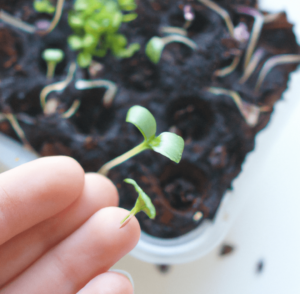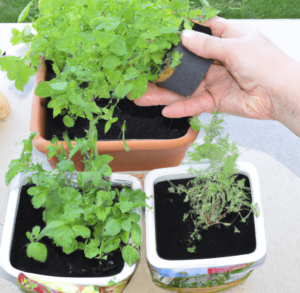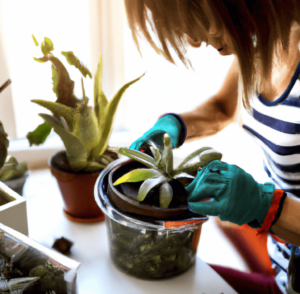Gardening is a popular hobby that allows people to connect with nature and grow their own fruits, vegetables, and flowers. However, traditional gardening methods can be time-consuming and resource-intensive, especially for those with limited space or soil quality. Keyhole gardening is a sustainable and efficient alternative that can be a great option for those looking to grow their own food in an environmentally friendly way.
What is a Keyhole Garden?
A keyhole garden is a small, circular garden bed that is designed to be highly productive and water-efficient. The bed is typically about four to six feet in diameter and has a compost pile in the center, which acts as a natural fertilizer for the plants. The bed is surrounded by a ring of raised soil, which helps to retain moisture and create a microclimate for the plants.
The compost pile in the center of the keyhole garden is a crucial element of this gardening method. As the plants grow and are harvested, the compost pile is replenished with organic matter such as kitchen scraps, yard waste, and other biodegradable materials. The decomposition of these materials provides nutrients for the plants and helps to improve the overall soil quality of the bed.
Benefits of Keyhole Gardening
One of the main benefits of keyhole gardening is its water efficiency. The raised soil ring helps to retain moisture, which means that the bed requires less water than a traditional garden. Additionally, the compost pile in the center helps to retain moisture, further reducing the need for watering. This is especially beneficial in areas with limited water resources or during times of drought.
Another advantage of keyhole gardening is its space-saving design. The small, circular shape of the bed allows it to be easily incorporated into a small backyard or balcony, making it a great option for those with limited space. The raised bed also means that the plants are easier to access and tend to, making it a convenient option for those with mobility issues or limited physical ability.
Keyhole gardening is also an environmentally friendly option as it promotes composting and the use of organic fertilizers. This not only helps to reduce waste, but it also helps to improve the overall health of the soil and support biodiversity in the garden.
Sustainability and Efficiency of Keyhole Gardening
Keyhole gardening is a sustainable and efficient alternative to traditional gardening methods. Its water-efficient design, small size, and use of organic fertilizers make it a great option for those looking to grow their own food in an environmentally friendly way. Whether you have a small backyard or a balcony, keyhole gardening is a convenient and rewarding way to enjoy the benefits of gardening.

Raised Bed Gardening
Raised bed gardening is a gardening method in which the garden bed is raised above the ground, typically using wood, stone, or metal frames. This type of gardening is popular because it allows gardeners to have more control over the soil conditions and can be easier on the back and knees since the bed is at a more comfortable height.
One type of raised bed gardening is called a keyhole garden. A keyhole garden is a circular raised bed with a compost pile in the center. The compost pile helps to provide nutrients to the plants in the bed and can be easily accessed from all sides of the bed.
Raised beds are a great option for gardeners with limited space, poor soil conditions, or disabilities that make it difficult to bend down to the ground. They can also be used to create a more visually appealing garden by separating different plants or incorporating decorative materials into the bed’s design.
Overall, raised bed gardening is a versatile and convenient way to grow a variety of plants and can be a great addition to any backyard or urban garden.
Benefits of Gardening in Raised Beds
Gardening in raised beds has a number of benefits compared to traditional in-ground gardening. One of the main benefits is that raised beds allow for better drainage and aeration of the soil, which can improve the overall health of the plants growing in them. This is especially important in areas with heavy clay soil or other soil types that may not drain as well.
Another benefit of raised beds is that they can help to conserve water. Because the soil in a raised bed is generally deeper than in an in-ground garden, it can hold more moisture, which means you may need to water your plants less often. In addition, the soil in a raised bed warms up faster in the spring, which means you can start planting earlier in the season.
Raised beds also allow for more control over the soil mix, which means you can tailor the soil to the specific needs of the plants you are growing. For example, if you are growing herbs or vegetables, you can add compost to the soil to improve its fertility.
Finally, raised beds can be a great option for those with limited space, as they can be easily incorporated into a small backyard or even placed on a patio or deck. They are also a great option for those who may have difficulty bending down or reaching the ground, as the height of the bed allows for easier access. Raised beds are also a great option for those who want to grow their own food for their kitchen.
Keyhole Garden Design and Features
A keyhole garden is a type of raised bed garden that is designed in the shape of a keyhole, with a circular center area surrounded by a rectangular outer bed. This design allows for easy access to the center area, which is typically used for composting organic matter and providing nutrients to the plants in the outer bed.
The plants in a keyhole garden are typically grown in baskets or containers filled with soil, which are placed in the outer bed. This allows for easier maintenance and crop rotation, as the baskets can be easily removed and replaced with new ones. The outer bed can also be used to grow a variety of plants, such as vegetables, herbs, and flowers.
One of the main benefits of a keyhole garden is its efficient use of space and water. The circular center area is used for composting and water collection, which helps to conserve resources and reduce the need for additional watering. Additionally, the raised bed design helps to improve soil drainage and prevent soil erosion.
Overall, a keyhole garden is a unique and efficient way to grow a variety of plants in a small space. Its compact design and resource-saving features make it an attractive option for gardeners looking to maximize their gardening space and resources.
Gardening Basics
Gardening involves the cultivation of plants, typically for decorative or practical purposes. It can be as simple as growing a few herbs on a kitchen windowsill or as complex as designing and maintaining a large backyard garden. There are many different ways to garden, depending on your available space, resources, and goals.
One common type of garden is the garden bed, which is a dedicated area of soil in which plants are grown. Garden beds can be located on the ground or raised up off the ground, and can be of any size or shape. Some people choose to build garden beds against a wall or fence, which can provide a sense of enclosure and can be helpful for training certain plants to grow in a certain direction.
Water is an essential component of any garden, as plants need water to survive and thrive. How much and how often you water your plants will depend on a variety of factors, including the type of plants you are growing, the soil they are planted in, and the local climate. It’s important to carefully monitor your plants and adjust your watering habits as needed to ensure that they are getting the right amount of moisture.
Bed and Composting Basics
A bed is an area of land used for a specific purpose, such as gardening or composting. In gardening, a bed is a designated area in which plants are grown. This area is usually surrounded by borders, such as edging or fencing, to define the space and protect the plants from being trampled by humans or animals.
In composting, a bed can also refer to a designated area for a compost pile. A compost pile is a collection of organic matter, such as leaves, grass clippings, and food scraps, that decomposes over time to create a rich, soil-like material called compost. Compost is often used in gardening as a natural fertiliser to improve the soil quality and nourish plants.
One type of bed that is gaining popularity in gardening is the keyhole garden. A keyhole garden is a raised bed with a circular shape and a small opening in the center, resembling the shape of a keyhole. The opening in the center is used to access the compost pile, which is located at the center of the bed. The keyhole garden is an efficient and sustainable gardening method that conserves water and reduces the need for chemical fertilisers.
In summary, a bed can refer to a designated area for gardening or composting, and is an important part of sustainable gardening practices such as the keyhole garden.
Composting is the process of breaking down organic matter, such as food scraps and yard waste, into a rich, soil-like substance called compost. This can be done in a designated area, such as a compost bin or compost pile, or in a composting wall or bed.
To create a compost pile or bin, you will need to designate a specific area in your yard or garden. The size of this area will depend on the amount of organic material you have to compost, but a good rule of thumb is to aim for a pile or bin with a diameter of at least three feet.
To start the composting process, you will need to add a layer of organic material to the designated area. This can include food scraps, yard waste, and other organic materials. Once you have added a layer of organic material, you will need to add water to the pile or bin to help speed up the decomposition process. Be sure to keep the compost moist, but not too wet, by adding water as needed.
With proper care and maintenance, your compost pile or bin should break down the organic material into rich, nutrient-rich compost within a few months to a year. You can then use this compost as a natural, organic fertilizer for your plants and garden beds.
Constructing a Compost Area for Gardening
Constructing a compost area in your garden can be a simple and effective way to recycle organic materials and create a rich soil amendment for your plants. Here are some steps to consider when constructing your compost area:
1. Choose an area in your garden that is easily accessible and has good drainage. Avoid areas that are prone to standing water or that receive direct sunlight for most of the day.
2. If you have a small garden, you may want to consider using a compost basket or bin to contain your compost pile. These can be purchased at a gardening supply store or made at home using wire fencing or wood.
3. If you have a larger garden, you can construct a compost pile directly on the ground. To do this, clear a spot in your chosen area and create a base using twigs, branches, or straw to allow for proper drainage.
4. Begin adding your compost materials to the pile or bin, including items such as leaves, grass clippings, food scraps, and coffee grounds. Mix these materials together and moisten them slightly to help facilitate the composting process.
5. Turn the compost pile regularly to oxygenate the materials and speed up decomposition. As the materials break down, you will notice the pile shrinking in size and the compost will become a rich, dark soil-like substance.
6. Once the compost is fully decomposed, it can be added to your garden beds as a soil amendment to help improve soil structure and fertility.
Raised Gardening: Keyhole Gardens and Garden Beds
Raised gardening refers to the practice of growing plants in elevated beds or containers, rather than in the ground. This method of gardening has a number of benefits, including improved drainage, warmer soil temperatures, and easier access for those with mobility issues.
One type of raised garden is the keyhole garden, which is a circular garden bed with a compost pile in the center. The compost pile helps to enrich the soil and retain moisture, while the circular shape of the bed allows for easy access to all areas of the garden. Keyhole gardens are popular in areas with limited space or poor soil quality.
Another type of raised garden is the garden bed, which is a rectangular or square-shaped bed that is elevated off the ground. Garden beds can be made from a variety of materials, including wood, brick, or stone. They can be used to grow a wide range of plants, from vegetables and herbs to flowers and ornamental plants.
Whether you choose a keyhole garden or a tradition garden bed, raised gardening is a great way to enjoy the benefits of gardening without the challenges of working with poor soil or limited space.

Bottom Line: Keyhole Gardening is Sustainable and Efficient Method of Gardening
Keyhole gardening is a sustainable and efficient method of growing fruits, vegetables, and flowers. It consists of a small, circular garden bed with a compost pile in the center, surrounded by a ring of raised soil. The compost pile provides nutrients for the plants and helps to improve the soil quality, while the raised soil ring helps to retain moisture and create a microclimate for the plants. Keyhole gardening is a space-saving, water-efficient, and environmentally friendly option for those looking to grow their own food.
If you’re interested in keyhole gardening, you may also be interested in in-ground gardening and lasagna gardening.







